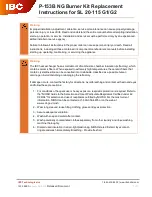
73
EN
5.4
Installation room
The location where the appliance is to be installed must comply
with the Technical Regulations and Legislation in force. It
must be equipped with suitably sized air vents for "TYPE B"
installations.
APPROXIMATE MINIMUM DISTANCES
≥
1 m
≥
1 m
Fig. 15
m
WARNINGS
– Remember to consider the space needed in order to
access the safety/adjustment devices and to carry
out maintenance interventions.
– The location where the appliance is to be installed
must be suitably protected from the weather.
d
IT IS FORBIDDEN
– To install
ALU HE
appliances outside if not suitably
protected from the weather.
5.5
New installation or installation of a
replacement appliance
When
ALU HE
boilers are installed on old systems or systems
requiring updating, it is recommended the installer checks that:
– the connecting flue pipe is suitable for the combustion
temperature of the appliance, calculated and manufactured in
compliance with Standards, that it is as straight as possible,
air tight, isolated, with no obstructions or restriction and
that it has appropriate condensate collection and evacuation
systems
– the electrical system is constructed by professionally qualified
personnel, respecting the specific regulations
– the fuel delivery line and the tank (LPG) comply fully with
specific Standards
– the expansion vessel ensures total absorption of the fluid
dilation in the system
– the pump flow-head performance is sufficient for the system
characteristics
– the system is clean, free of any sludge, deposits, de aerated
and air tight. For system cleaning, please refer to the relevant
paragraph.
– a supply/refill water treatment system is provided
– if there is an automatic filling system, a litre counter must
have been installed so as to know the total eventual losses.
m
CAUTION
The manufacturer declines all liability for any damage
caused by incorrect implementation of the system or
of the smoke outlet system or by an excessive use of
additives.
5.6
Cleaning the system
Before installing the appliance on a newly constructed system or
replacing a heat generator on an existing system, it is important
that the system is thoroughly cleaned to remove sludge, slag,
dirt, residue etc.
Before removing an old heat generator from an existing system,
it is recommended that the user:
– puts a descaling additive into the water system
– allows the system to work with the generator active for a few
days
– drains the dirty water from the system and flushes the system
with clean water once or more than once.
If the old generator has already been removed or is not available,
replace it with a pump to circulate water in the system and then
proceed as described above.
Once cleaning operations have been carried out and before
installing the new appliance, it is recommended that a fluid
is added to the water system to protect it from corrosion and
deposits.
m
CAUTION
For further information on the type of additive and
usage, please contact the appliance manufacturer.
5.7
Water system treatment
When filling and restoring the system it is good practice to use
water with:
– appearance: clear
– pH: 6÷8
– hardness: < 25°f
– the maximum content of chlorides allowed is 250 mg/l
– it is recommended that the total quantity of water to use,
including top-ups, with a total hardness of 20°F
DOES NOT
exceed 20 litres/kW
If the water hardness is more than 20°F, to calculate the total
quantity of water to use, use the formula: (20°F/hardness
measured °F) x 20.
Example with water hardness of 25°F: (20/25) x 20 = 16 l/kW
If the water characteristics are different from those indicated, it
is recommended that a safety filter is used on the water delivery
pipe to retain impurities, and a chemical treatment system to
protect against possible deposits and corrosion which could
affect boiler operation.
If the systems are only low temperature systems, it is
recommended that a product is used to prevent the development
of bacteria.
In any case, please refer to and comply with Legislation and
specific Technical Standards in force, (1989 standard UNI 8065 -
Water treatment in heating systems for domestic use).
NOTE:
the conversion factor between °dH (German degrees) and
°F (French degrees) is 0.56 (1°dH = 0.56 x °F).
m
CAUTION
– It is not recommended that the system be filled with
distilled or demineralised water, because they cause
serious corrosion to the aluminium heat exchanger.
– It is useful to note the quantities of water to fill the
system and top it up, and the values of the quality of
water used.
Содержание ALU HE
Страница 10: ...10 IT ...
Страница 22: ...22 IT ...
Страница 49: ...49 IT ...
Страница 50: ...50 EN ...
Страница 58: ...58 EN ...
Страница 70: ...70 EN ...
Страница 97: ...97 EN ...
Страница 98: ...98 ...
Страница 99: ...99 ...
















































